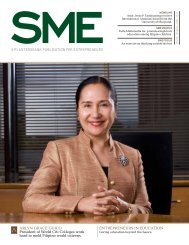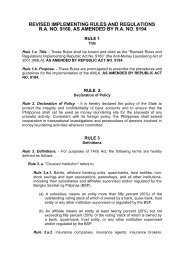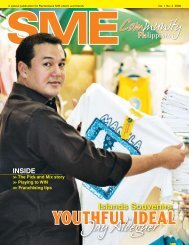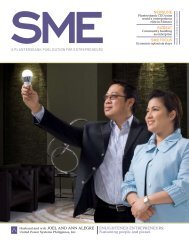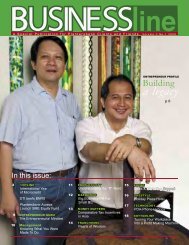Bicolano magic in a can - Planters Development Bank
Bicolano magic in a can - Planters Development Bank
Bicolano magic in a can - Planters Development Bank
Create successful ePaper yourself
Turn your PDF publications into a flip-book with our unique Google optimized e-Paper software.
TECHNOLOGY<br />
BY EDONG MENDOZA<br />
There are a million reasons why<br />
bus<strong>in</strong>esses—whether large or<br />
small—need to keep employee<br />
work hours <strong>in</strong> check. The most<br />
obvious reason of course is to ensure<br />
<strong>in</strong>dividual attendance records are consistent<br />
dur<strong>in</strong>g office hours.<br />
In the most part of the 20th century,<br />
timekeep<strong>in</strong>g methods were fully<br />
manual or semi-automated to an extent.<br />
Bundy clocks and time cards were<br />
the most popular means of tabulat<strong>in</strong>g a<br />
worker’s “<strong>in</strong>s and outs”. All one had to<br />
do was pop <strong>in</strong> a card <strong>in</strong>to a clock and<br />
presto – <strong>in</strong>stant attendance record. But<br />
the bundy clock system was, for lack of<br />
a better word, primitive and it had a lot<br />
of loopholes. Oftentimes, an employee<br />
could simply ask a co-worker to punch<br />
<strong>in</strong>/out for him just to avoid performance<br />
demerits or salary deductions. Worse off,<br />
if an employee was <strong>in</strong> cahoots with the<br />
timekeep<strong>in</strong>g officer, he or she could even<br />
get away with murder, so to speak.<br />
With the widespread <strong>in</strong>troduction<br />
of computers <strong>in</strong> the mid-‘90s, timekeep<strong>in</strong>g<br />
took on a more modern and familiar<br />
face. Magnetic cards that you <strong>can</strong> swipe<br />
or flash on a sensor became the most<br />
popular means of logg<strong>in</strong>g <strong>in</strong>. Big corporations<br />
even had the money to set up a<br />
computerized <strong>in</strong>frastructure to track an<br />
employee with<strong>in</strong> its premises solely by<br />
detect<strong>in</strong>g where the ID was last used.<br />
Aga<strong>in</strong> however, this is still prone to fraud<br />
as anyone – even a total – stranger could<br />
use a stolen or borrowed ID to punch <strong>in</strong><br />
and even ga<strong>in</strong> access to various parts of<br />
an office. And as mentioned, only big corporations<br />
at the time could afford to set<br />
up such a pricey system of computers.<br />
Enter the Philipp<strong>in</strong>es’ <strong>in</strong>ternet age<br />
a.k.a. the broadband boom of the early<br />
21st century. The many changes <strong>in</strong> computer<br />
use and the public acceptance of<br />
the <strong>in</strong>ternet have opened doors to employers<br />
(even the smaller ones) that no<br />
one even dreamed of a decade ago.<br />
Today, Biometric devices are a common<br />
sight <strong>in</strong> many offices. Biometrics <strong>in</strong><br />
simple terms means analyz<strong>in</strong>g a part of<br />
your body.<br />
The most common device thus far<br />
is the f<strong>in</strong>ger s<strong>can</strong>ner. It looks just like an<br />
ord<strong>in</strong>ary card-swipe module except that<br />
is uses a s<strong>can</strong>ner to recognize an <strong>in</strong>dividual’s<br />
f<strong>in</strong>gerpr<strong>in</strong>t. Given the very nature<br />
of f<strong>in</strong>gerpr<strong>in</strong>t patterns, this is <strong>in</strong> theory a<br />
fraud-proof and accurate system. Technically,<br />
the only way anyone <strong>can</strong> bypass the<br />
system is to try to copy someone’s f<strong>in</strong>gerpr<strong>in</strong>t<br />
us<strong>in</strong>g specialized forensic equipment<br />
and techniques or by other means<br />
that are too morbid to mention here.<br />
The <strong>in</strong>creased connectivity with the<br />
<strong>in</strong>ternet and <strong>in</strong>tra-office networks also<br />
takes this system of timekeep<strong>in</strong>g a step<br />
higher. By utiliz<strong>in</strong>g the power of the web,<br />
transactions <strong>can</strong> now be conducted onl<strong>in</strong>e<br />
simply by logg<strong>in</strong>g on to a website.<br />
Officers will be alerted via email if an employee<br />
is request<strong>in</strong>g for an approval and<br />
conversely, the employee will be notified<br />
if the transaction has been approved.<br />
It’s fast, it’s hassle free, and it elim<strong>in</strong>ates<br />
confusion s<strong>in</strong>ce the transaction no longer<br />
<strong>in</strong>volves a middle man.<br />
Before, transactions had to be done<br />
manually <strong>in</strong> the office <strong>in</strong> the presence of<br />
managers and timekeep<strong>in</strong>g officers. More<br />
people <strong>in</strong>volved means more chances<br />
for th<strong>in</strong>gs to get lost <strong>in</strong> translation. There<br />
have been many cases when employees—through<br />
no fault of their own—had<br />
to accept unnecessary salary deductions<br />
because of unapproved official bus<strong>in</strong>ess<br />
(OB) and overtime (OT).<br />
With this new and <strong>in</strong>novative system,<br />
employers are now also given <strong>in</strong>stant<br />
feedback of employee attendance.<br />
By observ<strong>in</strong>g the collected data, managers<br />
<strong>can</strong> optimize or customize company<br />
work hours depend<strong>in</strong>g on how they see<br />
fit. Say for example if a work shift of 9am<br />
to 5pm results <strong>in</strong> frequent tard<strong>in</strong>ess,<br />
managers have the option to adopt a later<br />
shift that ma<strong>in</strong>ta<strong>in</strong>s the same or better<br />
level of productivity.<br />
With all the benefits of this new system<br />
however, we should remember that<br />
this is just a tool and will not guarantee<br />
sweep<strong>in</strong>g changes <strong>in</strong> the workforce without<br />
the participation of the employees.<br />
Increased productivity and security still<br />
rely on how the system is implemented<br />
and how well its purpose is understood<br />
by employees on all levels.<br />
Photo from dreamstime.com<br />
23<br />
VOL. NO. 03 / ISSUE NO. 05



